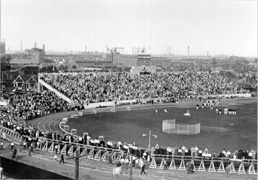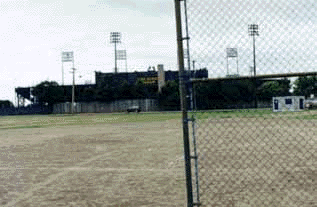
 Official Name:
Official Name:
The property that today includes Ivor Wynne Stadium, Brian Timmis Stadium (and Parkette), Scott Park, Scott Park School, and Jimmy Thompson Memorial Pool was originally called Scott Park, after John J. Scott, the former owner. John J. Scott (1854 - 1916) was one of Ontario's best-known lawyers. He was also a businessman who helped bring several industries to the area (such as International Harvester, Imperial Cotton, and Dominion Beltings) and helped form the Aberdeen Brick Yards. His land originally belonged to the Gage family. During the First World War, a barracks, officers' quarters, and hospital were set up on the property. Mr. Scott always intended the this land be used as a park, which he named "Central Park" in his survey plans, and he had approached the City several times to purchase it from him. In 1912, the city bought 21 acres of land from J. J. Scott for $60 000, almost one-third the price Mr. Scott was asking for, to create a new park. The property was given to the Parks Board on March 19, 1915.
On January 1st, 1920, a sum of $150 000 was voted to be used for the construction of the civic athletic field at Scott Park and for improvements to other parks in Hamilton. The money was used at Scott Park to improve the civic park system by adding children's playgrounds, children's wading pools, soccer and rugby football fields, baseball grounds and grandstands, a cricket pitch, tennis courts, softball diamonds, and bowling greens.

In 1929, a swimming pool (now the Jimmy Thompson Memorial Pool) was built and was ready for use in 1930. Alderman Sam Clarke thought of the idea for a civic stadium at Scott Park, which was built in 1930. Both the pool and the civic stadium wee built for the first British Empire Games, which were held at the park in 1930. This event brought together the best athletes of eleven countries of the British Commonwealth of Nations. Five hundred competitors and officials participated in the week's program, which consisted of athletics, rowing, boxing, wrestling, swimming, diving, and lawn bowling. In addition to the Empire events, international rowing and canoeing championships were also conducted, as were Canadian track and field championships for women, Canadian canoe championships, international yachting, and Ontario schoolboy championships - with the result that over 2,000 athletes gathered in Hamilton during the time of the competitions.
In 1940, a lighting system was installed making night ball and rugby games possible. Later, a scoreboard was put in at the baseball center. On August 6, 1941, a fire broke out in the main grandstand costing approximately $20,000 in damages. However, the west end and east end of the stands were not damaged so the sports programs were able to continue with the ruined section barricaded to prevent any accidents. On November 3, 1941, the Parks Board decided to have the stands repaired, costing about $11,500. The new stands would seat about 21,000 people, whereas the old stands accommodated only 2,268.

In June of 1953, 3,000 new seats were added to the north end of the Civic Stadium. Five years later, the seats that were originally at the south end were torn down and a new bowl-shaped south stand was constructed, adding another 5,000 seats.
On November 6, 1962, the city recreation department opened its first indoor ice rink at Scott Park. The ice surface was 175 feet by 72 feet. Mayor Lloyd Jackson showed off an impressive "slap shot" to declare the rink officially open. Scott Park Arena was renovated in 1986, costing $600,000. The rink's concrete slab had settled on three sides, cracking the surface and putting stress on the pipes running through it. The rink surface was replaced as well as the corroded piping used to circulate coolant through the floors.
In 1963, an area of 1.4 acres beside the swimming pool was proposed as the site for the building of a new high school. Scott Park High School was completed in September of 1966.
On December 9, 1970, the Parks Board voted to rename the former Civic Stadium as Ivor Wynne Stadium to honour Ivor Wynne for his contributions to the Parks Board, McMaster University, and the local and national sports scenes. Renovations took place the following year. The site was officially named again on February 9, 1988.
